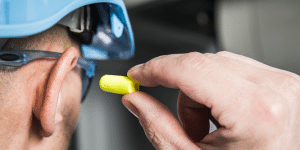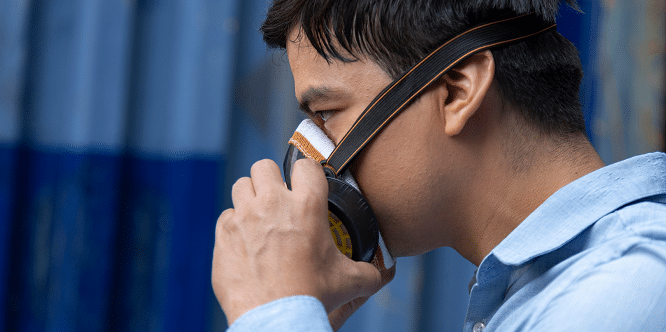TAKEAWAY: To ensure the proper fit and seal of a respirator, it is essential that employers conduct a user seal check regularly. A user seal check is a quick test that helps determine if the respirator is fitted correctly to the user’s face and provides an effective seal.
Jump Ahead
Respirators have always been an essential part of personal protective equipment (PPE) used in various industries to protect workers, particularly those in hazardous work environments, from inhaling harmful particles or gases. However, the effectiveness of a respirator is highly dependent on its fit and seal, and with emerging infectious disease outbreaks and increasingly smaller particles, performing proper fit testing is crucial. If there is a leak between the respirator and the user’s face, harmful particles or gases can still enter the respiratory system, putting the worker’s health at risk.
Positive and Negative Pressure Checks
There are two types of user seal checks: the positive pressure check and the negative pressure check. Not every respirator can be checked using both positive and negative pressure checks, so be sure to check your manufacturer’s recommendations or work with a professional. Both tests are equally important because they check for different things. A positive pressure check ensures that there are no leaks on the inhalation side of the mask, while a negative pressure check ensures that there are no leaks on the exhalation side of the mask.
Positive Pressure Checks
During a positive pressure user seal check, the respirator user gently exhales while blocking the paths for air to exit the facepiece. A successful check is when the facepiece is slightly pressurized without any evidence of outward air leakage at the seal. Evidence that the seal is faulty can include a feeling of air movement along the face at the point of the seal, glasses fogging or a lack of pressure inside the facepiece. Positive pressure checks may not be possible if the respirator has an exhalation valve. In this case, employers should use a negative pressure check.
The Negative Pressure Check
The negative pressure check involves covering the filter cartridges with the palms of the hands and inhaling gently. If the respirator collapses slightly and stays collapsed without any air leaking in, it indicates a proper fit and seal. During a negative pressure user seal check, the respirator user sharply inhales while blocking the paths for air to enter the facepiece. This includes, for example, covering the filter cartridges. A successful check is when the facepiece collapses slightly and remains collapsed without any air leaking in under the negative pressure created with this procedure.
Hazards Help Determine Which Seal Test to Use
In some cases, one test may be more appropriate than the other depending on the specific respirator and the hazards present. For example, a positive pressure check may be more critical for respirators used in environments with high levels of particulates. In contrast, a negative pressure check may be more vital for respirators used in environments with high levels of gases or vapours.
Whenever possible, however, workers or employers should perform both tests to ensure that it is functioning correctly and providing the intended level of protection.
When to do a Seal Check
User seal checks should be conducted every time a respirator is used, even if it is the same respirator that has been used before. This is because facial features, such as facial hair, weight gain and loss, or dental work, can change over time and affect the fit and seal of the respirator.
The Business Case for Conducting Seal Checks
The importance of conducting user seal checks cannot be overstated. A poorly fitting respirator can lead to various health risks, including respiratory illness, lung damage, or even death. Additionally, using a respirator with a poor fit and seal can give workers a false sense of security, leading them to engage in risky behaviour that they would otherwise avoid.
Employers are responsible for providing their workers with properly fitting respirators and ensuring that they are trained on the importance of conducting user seal checks. This includes providing workers with guidance on how to perform the checks and the consequences of not doing so. Additionally, employers should ensure that their workers have access to a variety of respirator sizes and models to accommodate individual facial features and preferences.
Conducting user seal checks on respirators is an essential part of ensuring workers’ safety in various industries. It is a quick and simple test that can prevent serious health risks and should be conducted every time a respirator is used. Employers are responsible for providing their workers with the necessary training and equipment to conduct user seal checks and ensure that they are performed correctly.
You May Also Be Interested In…
- Do You Have Reasonable Suspicion?
 Employers cannot initiate reasonable suspicion testing without first going through the 5-step process. Reasonable suspicion training provides critical information about how to initiate reasonable suspicion testing, including the 5-step process and other tools that employers can use to help manage the misuse of alcohol and drugs in the workplace.
Employers cannot initiate reasonable suspicion testing without first going through the 5-step process. Reasonable suspicion training provides critical information about how to initiate reasonable suspicion testing, including the 5-step process and other tools that employers can use to help manage the misuse of alcohol and drugs in the workplace. - An Employer’s Guide: What You and Your Employees Need to Know About DOT Drug & Alcohol Testing
 When implementing or maintaining DOT Drug & Alcohol testing, there are key areas that employers should consider.
When implementing or maintaining DOT Drug & Alcohol testing, there are key areas that employers should consider. - SureHire Occupational Testing Acquires COHR Health: A Positive Step Towards Safe, Healthy, Productive Workforces and Communities
 We are thrilled to announce that today, May 6, 2024, SureHire Occupational Testing has officially acquired COHR Health, a well-known leader in occupational health services. Read on…
We are thrilled to announce that today, May 6, 2024, SureHire Occupational Testing has officially acquired COHR Health, a well-known leader in occupational health services. Read on… - Occupational Testing Use Case – Mining
 In this case study, we will explore how mining companies can use various types of occupational tests to reduce Total Recordable Incident Rates (TRIR) long term.
In this case study, we will explore how mining companies can use various types of occupational tests to reduce Total Recordable Incident Rates (TRIR) long term. - 9 Strategies to Keep Workers Cool on Drilling Sites During Hot Summer Months
 This article delves into strategies to keep workers cool and safe on drilling sites during the hot summer months.
This article delves into strategies to keep workers cool and safe on drilling sites during the hot summer months. - Hearing Conservation Basics: How to Manage Occupational Noise
 Learn how to proactively mitigate occupational noise risks and help prevent NIHL among workers.
Learn how to proactively mitigate occupational noise risks and help prevent NIHL among workers.

